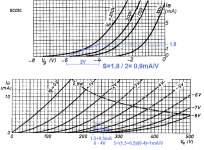Hello.
Can someone help, like a tutorial, how to plot and find trans-conductance for a valve (ECC81) for a given Ia(plate current).
In the datasheet the trans-conductance change with Ia and Va. In the datasheet it is 5.5mA/V for 10mA at 250V, but how can I find how much for 1mA at 250V ?
Thank you.
Can someone help, like a tutorial, how to plot and find trans-conductance for a valve (ECC81) for a given Ia(plate current).
In the datasheet the trans-conductance change with Ia and Va. In the datasheet it is 5.5mA/V for 10mA at 250V, but how can I find how much for 1mA at 250V ?
Thank you.
Thank you walter.
I found it, So grateful thank you.
I will try to find everything i can about valve noise !
EDIT : Do you have the same thing for the ecc83 (I can't find it with curves) and ecc88 ?
I found it, So grateful thank you.
I will try to find everything i can about valve noise !
EDIT : Do you have the same thing for the ecc83 (I can't find it with curves) and ecc88 ?
Last edited:
Goes like this, two possebilities.🙂Can someone help, like a tutorial, how to plot and find trans-conductance for a valve (ECC81) for a given Ia(plate current).
how can I find how much for 1mA at 250V ?
Is a proxamation, like everything with tubes 😀
Mona
Attachments
Regarding the valve noise I suggest you to build a test citcuit where you can change the anode and catodhe resistors function of the tubes you are testing
Then you need some instruments to measure the amplification factor, then the residual with the input shorted ( 600 ohm standard)
A good audio card with ARTA software ( for example).
This is the only way to get the right results about noise.
You can have different value of s/n in the same brand for the same type of tubes
Of course you need dc regulated power for filaments an HT
Walter
Then you need some instruments to measure the amplification factor, then the residual with the input shorted ( 600 ohm standard)
A good audio card with ARTA software ( for example).
This is the only way to get the right results about noise.
You can have different value of s/n in the same brand for the same type of tubes
Of course you need dc regulated power for filaments an HT
Walter
That is what I will do, but I wanted to be able to interpret the results.
In this case at 1ma, it seems the ecc81 is almost an Ecc83 with less mu.
In this case at 1ma, it seems the ecc81 is almost an Ecc83 with less mu.
Last edited:
Please check on real circuit.
You have to consider the resistors and voltage you are using.
All of them have a weight for the final results.
An high value of R has more noise than the lower ones
If you use a pentode in triode connection you will get a good gain with a low noise due to the high gm and low Rp ( you have to choice carefully the type)
Walter
You have to consider the resistors and voltage you are using.
All of them have a weight for the final results.
An high value of R has more noise than the lower ones
If you use a pentode in triode connection you will get a good gain with a low noise due to the high gm and low Rp ( you have to choice carefully the type)
Walter
Thank you I will follow your advice. I will not forget the resistor values.
I said the 81 is the same, because at 1mA it has high Internal resistance like the 83.
I said the 81 is the same, because at 1mA it has high Internal resistance like the 83.
At which Va?
The 81 has the 20% less as Rp
The graphics in the data shee must be read carefully
Walter
The 81 has the 20% less as Rp
The graphics in the data shee must be read carefully
Walter
- Home
- Amplifiers
- Tubes / Valves
- Help, how to plot transconductance for a valve
